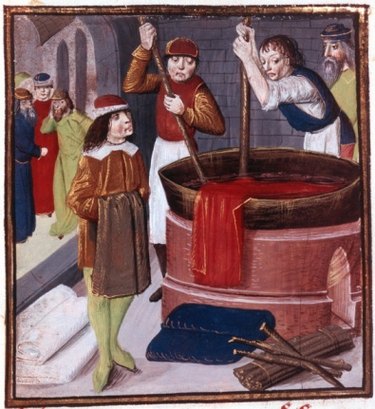
Dyeing is a traditional way of coloring fabric and has been practiced for hundreds of years. Calico is 100 percent cotton, so lends itself to dyeing because it can easily absorb the pigments. A number of dyeing methods are available for calico, ranging from traditional natural dyes to modern, synthetic ones.
Natural Dyes
Video of the Day
Natural dyes are those that come from plants, insects or minerals. It is an ecologically friendly way to dye calico. A natural dye gives the fabric a more subtle color variation than synthetic dye. It needs a mordant chemical, such as glaubersalt, to set it, however, and this may also be found in a synthetic dye. Natural dyes can age better than chemical dyes and develop into different tones when exposed to sunlight. You need a lot of dye to stain cloth, so if you are dyeing a lot of calico, it might not be practical or cost effective to use natural dyes.
Video of the Day
Cold Water Dyes
Smaller pieces of calico are suited to cold water dyes. But be prepared because it could get messy. The fabric is soaked in a diluted dye in a large bucket, bath or sink. Mixing up the dye, submerging the material, wringing it out and maneuvering it to a washing machine can be cumbersome. The dye can drip onto your clothing, carpet or floor. Plastic gloves are useful in performing this type of dyeing. Dylon and Rit manufacture cold water dyes for home use and are readily available in craft stores.
Machine Washable Dyes
Machine washable dyes are a more practical option for dyeing large amounts of calico. Quilts, curtains or sheets may benefit because the washing machine gives a more even coat of dye and consequently a more professional result. It also eliminates any spillage that can occur with cold water dyeing. Plus, as the Tintex website explains, hot water dyes do not need a caustic, or setting, agent.
Tie-Dye
If you tie up your calico using elastic bands, you can create hippie tie-dye patterns. Calico is ideal for this form of dyeing because it is 100 percent cotton and absorbs the dye easily. Tie-dyeing does not work unless the fabric is at least 60 percent cotton. You can create colorful, interesting fabric with tie-dye kits. If you do explore this option, follow the tie-dye instructions closely to obtain spectacular results.